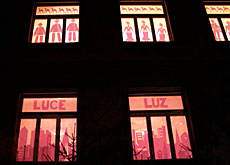
Swiss schools celebrate multicultural Christmas

Traditional Christmas celebrations have taken on a more diverse flavour in many schools due to a growing number of students from other cultural backgrounds.
In urban areas with a higher proportion of immigrants, multicultural festivities are widespread, while in more rural and Catholic regions tradition still holds sway.
Twenty years ago the proportion of Swiss who were members of the two leading Catholic and Protestant churches stood at 92 per cent, but this figure has now dropped to 75 per cent.
Between 1990 and 2000 religious pluralism won ground, and the number of people following other faiths doubled to about seven per cent of the population.
As religion is taught as a subject in Swiss schools, this increased diversity has also had an impact in the classroom.
Switzerland’s federal system means that the country’s 26 cantonal education departments define the rules for religious instruction in schools. Most of them teach religion as a non-denominational comparative course that surveys religions of the world.
No directives
How should Christmas, one of the most important Christian holidays, be celebrated in a multicultural school?
At a primary school in the suburbs of Zurich, immigrants make up 60 per cent of the pupils, many of whom are non-Christian, including a fair number of Muslims.
“We’re a multicultural community here so Christmas isn’t really at the forefront,” headmaster Rolf Kenel of the Bühl school in Wiedikon told swissinfo. “At the same time, we’re not going to simply ignore the holiday.”
“An examination of Christmas and its meaning in our culture takes place, but not in a missionary sense.”
The most important elements of the Christmas celebration are a lantern procession and the singing of Christmas carols in the church, with songs from religions around the world.
Five principles
In the Basel region, 18 per cent of students are Muslim and 13 per cent belong to other non-Christian beliefs.
“That has an effect on how we look at Advent in our schools,” Hans-Georg Signer, of Basel City’s education department, told swissinfo.
In acknowledgement of this religious diversity, the authorities drew up five principles to help schools decide how to celebrate Advent and Christmas.
The aim is to enlighten students about an important religious holiday and further understanding of cultural phenomena in the community.
It must be possible for the entire class to experience the festivities without hurting religious feelings, while another goal is to positively portray holidays from other beliefs, according to the guidelines.
Free choice
The region around the capital, Bern, has no regulations on how its schools should approach Christmas.
There are only recommendations on how to deal with biblical themes in the curriculum.
“Denominational neutrality is the most important rule,” Johannes Kipfer of the cantonal education department told swissinfo.
Parents of other faiths can have their children officially excused from lessons with religious content. “But this hardly ever happens,” he said.
According to Kipfer, Advent and Christmas celebrations are very popular among non-Christian children.
No exceptions
The authorities in Geneva emphasise the secular character of their schools.
“Christmas is observed as a cultural experience,” the cantonal education department said.
Therefore all students are required to participate in pre-Christmas activities. But, in any case, it is not permitted to attach any religious significance to them.
During Advent, local schools celebrate the Escalade, the historic battle that saw the city repel an invasion from the Duke of Savoy in the 17th century.
Tradition reigns
In Sorengo, a town in Italian-speaking Switzerland, both of Maria Rosaria Valentini’s sons attend the local primary school, which has very few non-Catholic pupils.
This is the main reason why most schools in canton Ticino still celebrate Christmas traditionally, Valentini says.
Each year their school organises a get-together on December 8, the Feast of the Immaculate Conception, a Catholic holiday leading up to Christmas.
On that day there are no morning lessons. Then in the afternoon a nativity play is performed, Christmas carols are sung and a traditional late afternoon meal is eaten.
Religious affiliation in Switzerland:
42% Catholic, 35.2% Protestant, 4.3% Muslim, 1.8% Orthodox, 0.2% Jewish, 5.5% other religions, 11% no affiliation
Advent is the period of prayer and fasting leading up to Christmas. It includes four Sundays and its starting date varies.
Christmas is Christianity’s most important holiday. It takes place on December 25 and celebrates the birth of Jesus Christ.
Jesus’ birth is further celebrated on January 6, the Feast of the Epiphany. The Epiphany celebrates the divine manifestation of Christ to the Magi.
(Adapted from German by Kathleen Peters)

In compliance with the JTI standards
More: SWI swissinfo.ch certified by the Journalism Trust Initiative




























You can find an overview of ongoing debates with our journalists here . Please join us!
If you want to start a conversation about a topic raised in this article or want to report factual errors, email us at english@swissinfo.ch.